Robert H. Adleman was an American novelist and historian. His book Devil's Brigade, about World War II, was turned into a film in 1968.

The 1st Special Service Force was an elite joint American–Canadian commando unit in World War II created and formed by Major General Robert T. Frederick of the Operations Division of the U.S. General Staff. During the Italian campaign of WWII it was commanded by Frederick and attached to the United States Fifth Army. The Force was later attached to 1st Airborne Task Force which was commanded by then Major General Frederick in August 1944 for the campaign in southern France.

The Horse Soldiers is a 1959 American adventure war film set during the American Civil War directed by John Ford and starring John Wayne, William Holden and Constance Towers. The screenplay by John Lee Mahin and Martin Rackin was loosely based on Harold Sinclair's 1956 novel of the same name, a fictionalized version of Grierson's Raid in Mississippi.
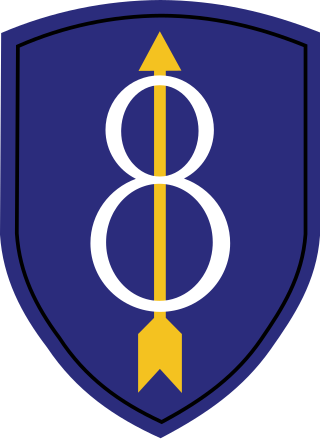
The 8th Infantry Division, ("Pathfinder") was an infantry division of the United States Army during the 20th century. The division served in World War I, World War II, and Operation Desert Storm. Initially activated in January 1918, the unit did not see combat during World War I and returned to the United States. Some units would serve in the American Expeditionary Force to Siberia. Activated again on 1 July 1940 as part of the build-up of military forces prior to the United States' entry into World War II, the division saw extensive action in the European Theatre of Operations. Following World War II, the division was moved to West Germany, where it remained stationed at the Rose Barracks in Bad Kreuznach until it was inactivated on 17 January 1992.
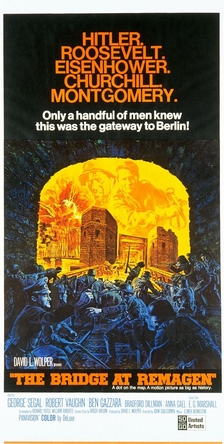
The Bridge at Remagen is a 1969 DeLuxe Color war film in Panavision starring George Segal, Ben Gazzara, and Robert Vaughn. The film, which was directed by John Guillermin, was shot in Czechoslovakia. It is based on the nonfiction book The Bridge at Remagen: The Amazing Story of March 7, 1945 by writer and U.S. Representative Ken Hechler. The screenplay was adapted by Richard Yates and William Roberts.
Andrew Victor McLaglen was a British-born American film and television director, known for Westerns and adventure films, often starring John Wayne or James Stewart.

The Battle of Monte La Difensa took place between 3 December and 9 December 1943 during Operation Raincoat, part of the Battle for the Bernhardt Line during the Italian campaign in World War II.

Major General Robert Tryon Frederick was a senior United States Army officer. During World War II, he commanded the 1st Special Service Force nicknamed the "Devil's brigade" by the Germans, and the 1st Allied Airborne Task Force an ad hoc division-sized airborne formation, commanding the task force as a Brigadier General during Operation Dragoon. As a Major general at 37 years old from December 3rd, 1944 until September of 1945 he commanded the 45th Infantry Division during the Western Allied invasion of Germany and the Allied-occupied Germany that followed. He was twice awarded the Distinguished Service Cross and was a recipient of a remarkable eight Purple Hearts received from combat during World War II.

Jack Watson was an English actor who appeared in many British films and television dramas from the 1950s onwards.
German-Americans were the largest ethnic contingent to fight for the Union in the American Civil War. More than 200,000 native-born Germans, along with another 250,000 1st-generation German-Americans, served in the Union Army, notably from New York, Wisconsin, and Ohio. Several thousand also fought for the Confederacy. Most German born residents of the Confederacy lived in Louisiana and Texas. Many others were 3rd- and 4th-generation Germans whose ancestors migrated to Virginia and the Carolinas in the 18th and early 19th centuries.
Operation Balavegaya was a combined military operation launched by the Sri Lankan military in Jaffna, the largest amphibious assault in its history. Operation Balavegaya was launched in response to the siege of Elephant Pass by the LTTE. It is believed that Operation Balavegaya was the largest and most successful military operation of the Sri Lankan military until Operation Riviresa in 1995.

Night People is a 1954 American thriller film directed, produced and co-written by Nunnally Johnson and starring Gregory Peck, Broderick Crawford, Anita Björk and Buddy Ebsen. The story was co-written by Jed Harris, the theatrical producer.
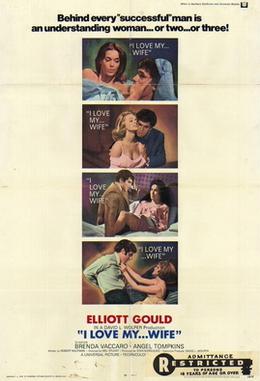
I Love My Wife, stylized as I Love My...Wife, is a 1970 American comedy film directed by Mel Stuart. It stars Elliott Gould and Brenda Vaccaro.
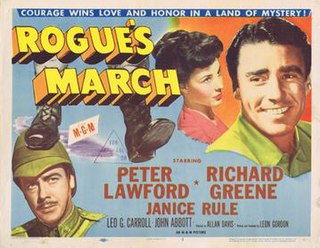
Rogue's March is a 1953 American historical adventure film directed by Allan Davis, with special location sequences directed by Geoffrey Barkas, and starring Peter Lawford, Richard Greene, and Janice Rule. It was partly shot on location in the Khyber Pass.
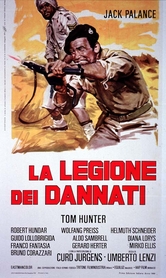
Battle of the Commandos is a European Macaroni-War film directed in 1969 by Umberto Lenzi. The movie was a co-production between Italy, West Germany and Spain.

Revolt at Fort Laramie is a 1957 American Color by Deluxe Western film directed by Lesley Selander and starring John Dehner, Gregg Palmer, Frances Helm and Don Gordon. The film was shot in Kanab, Utah with Harry Dean Stanton making his debut in the film.
The 1916 Birthday Honours were appointments by King George V to various orders and honours to reward and highlight good works by citizens of the British Empire. The appointments were made to celebrate the official birthday of The King, and were published in The London Gazette and in The Times on 3 June 1916.
The 1919 Birthday Honours were appointments by King George V to various orders and honours to reward and highlight good works by citizens of the British Empire. The appointments were made to celebrate the official birthday of The King, and were published in The London Gazette from 3 June to 12 August. The vast majority of the awards were related to the recently ended War, and were divided by military campaigns. A supplementary list of honours, retroactive to the King's birthday, was released in December 1919.
The 1918 New Year Honours were appointments by King George V to various orders and honours to reward and highlight good works by citizens of the British Empire. The appointments were published in The London Gazette and The Times in January, February and March 1918.












